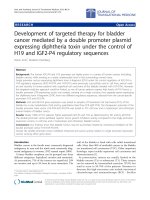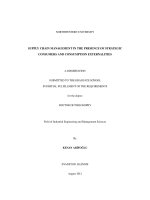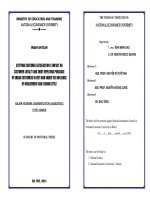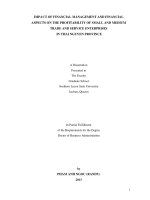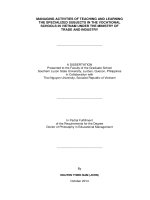Group Assignment Zara’s Supply Chain Management Under The Impacts Of Technology And Covid-19.Pdf
Bạn đang xem bản rút gọn của tài liệu. Xem và tải ngay bản đầy đủ của tài liệu tại đây (3 MB, 21 trang )
<span class="text_page_counter">Trang 1</span><div class="page_container" data-page="1">
<b>GROUP ASSIGNMENT: ZARA’S SUPPLY CHAIN MANAGEMENT UNDER THE</b>
<b>IMPACTS OF TECHNOLOGY AND COVID-19</b>
Group 6:Đỗỗ Đăng Khoa - SS170693T Th Bích Diễỗm – SS171321ạ ịNguyễỗn Trương Quỳnh Nh – SS170772ư
Ph m Th An Th – SS171196ạ ị ưNguyễỗn H ng T nh Nhi – SS171151ư ị
Nguyễỗn Th Bích Ng c – SS1ị ọ 70863Class: IB1712
Subject: SCM201
Lecturer: Nguyễỗn H u Hoàng Giao - ữ : 13 March 2023<small>th</small>
</div><span class="text_page_counter">Trang 2</span><div class="page_container" data-page="2">ZARA’S AGILE SUPPLY CHAIN...2
1. Fast fashion...2
2. Vertical integration-in-house manufacturing capabilities...2
3. Quick response to market trends...2
ZARA’S USE OF TECHNOLOGY AND THEIR BENEFITS...0
1. Radio frequency identification technology ( RFID)...0
1.1. Individual identification garments...0
1.2. High customer experience...1
1.3. Solution for shoplifting and anti-theft...2
2. Use of data analytics for demand forecasting and decision making...2
3. AI...4
4. PDAs create a hybrid model for the flow of information from stores to headquarters...4
THE IMPACTS OF COVID 19 ON ZARA’S SUPPLY CHAIN...5
1. Disruption of global supply chain and economy...5
2. Shortage of materials, delay in production and delivery...6
3. Changes in workforce...7
4. Shift towards E-commerce...7
ZARA’S RESPOND TO THE PANDEMIC...8
</div><span class="text_page_counter">Trang 3</span><div class="page_container" data-page="3">Zara is one of the world's leading fashion companies, known for its wide range of products and good customer service. The success of ZARA comes from many areas and supply chain is one of thereasons for its success. ZARA is about smart and efficient supply chain management. In this essay we will analyze how technology has changed aspects of corporate supply chain management and the impact of the COVID pandemic on the company's supply chain.
Source: SCM Globe
</div><span class="text_page_counter">Trang 4</span><div class="page_container" data-page="4"><b>1. Fast fashion</b>
Fast fashion is when items are produced quickly and the code is constantly renewed. The criterion of the fast fashion trend is to focus on many models and quickly bring to the market, hitting the psychology of young people who tend to always innovate according to trends.
Zara produces 10,000 designs annually, more than twice as fast as its industry competitors. Most Zara products only have a 4 week lead time from design to availability, although these products must go through DCs in Arteixo and Zaragoza before being shipped to the store. This shortening process makes supply and distribution work faster and ends Zara as the king of fast fashion. In addition, Zara also adheres to the principle of Just In Time tightening, eliminating all inappropriate processes to ensure uniform operation: products are manufactured to the right standards, right models, right places and the right time.[ CITATION Ego22 \l 1033 ]
<b>2. Vertical integration-in-house manufacturing capabilities</b>
Vertical Integration is a strategy whereby a company owns or controls its suppliers, distributors or retail locations to control the supply and value chain. This is also the strategy adopted by Zara, they self-manage, design, manufacture, ship, display, advertise, sell and respond. This gives Zara maximum control over its operations, and the strategy also makes transitions between stages in the Zara product cycle smoother.[ CITATION LễH20 \l 1033 ]
<b>3. Quick response to market trends</b>
ZARA's business point of view is loved and reacts quickly to the development trend of world fashion, so Zara quickly responds to market trends. ZARA has more than 200 designers who regularly participate in social events in general and fashion in particular to observe and keep up with the prevailing trends at different times. ZARA's products are very rich and diverse in design, mainly including clothes and accessories for both men and women of all ages.
</div><span class="text_page_counter">Trang 5</span><div class="page_container" data-page="5">For example, the clothing of this casual brand is also updated from the latest trends on the forum and the red carpet. Instead of taking 5 to 7 months to order clothes, force app vendors to reduce the time to bring items to the store to 22 months. The new outfits were completed and delivered to the store less than three weeks after being drawn on paper. While normally, the publishing time of the studios in general must last from 30 to 60 days.
To cut down on "fashion" time such as waiting for material to be supplied, Zara chooses to make use of all available fabric sources to make costumes. Sometimes, each Zara store only imports four to five pieces for a design. That is the reason why the company's products are always at risk of "selling out". Even accessories are sold so quickly that most customers have to wonder "Buy or not?" after the fear will no longer see the product appear in the next purchase.
"When you go to see a Gucci or Chanel outfit in October, you can still buy it in February next year. But with Zara, if you don't buy it right away, you won't see it last for 11 days. Or is to buy, or never to own again. And with the price so low, you have to buy it now," said Masoud Golsorkhi, editor of the Tank style magazine.
</div><span class="text_page_counter">Trang 6</span><div class="page_container" data-page="6"><b>1. Radio frequency identification technology ( RFID) </b>
RFID (Radio Frequency Identification) is a wireless system that consists of two components: tagsand readers. Zara uses tags to manage her business. Tags can be passive or active, communicating their identity and other information to nearby readers via radio waves. RFID is transforming the ZARA apparel industry. This is due to the fact that RFID enables retailing stores to achieve clear visibility and availability of products on the shelf
<b>1.1. Individual identification garments</b>
Firstly Zara Allows individual identification of clothing products through radio signals including. The second is Efficient Product Delivery: Zara follows a deep, predictable and fast pace, based on prompt deliveries to stores. Zara's strong distribution network allows the company to deliver to stores in Europe within 24 hours and to stores in the US and Asia in less than 40 hours. Third is Accurate In-Store Product Management and Reliable Inventory and Inventory Quantity: Zara has 12inventory turns per year compared to 3 – 4 annual turns for its competitors' painting. Stores order twice a week and this drives factory scheduling. In addition, inventory optimization will be delivered to each of their retail stores via twice-weekly outbound shipments. That ensures that each store gets only what they need. Avod uncommon inventory build-up. Finally, the RFID system
</div><span class="text_page_counter">Trang 7</span><div class="page_container" data-page="7">customer experience and creating a good brand in the eyes of customers.[ CITATION Qui18 \l 1033 ]
<b>1.2. High customer experience</b>
That it is responsible for the high level of customer satisfaction. For example, if one of the ZARA stores does not have a specific product, the staff can quickly determine its availability in nearby stores using product ID rather than calling or visiting them. Furthermore, ZARA is notified immediately when the quantity of a specific product is about to run out in the store, allowing themto replenish the quantity in a timely manner. Zara can reduce waste and costs by producing only what is needed and avoiding overstocking or markdowns. This improves profitability and sustainability
Uniqueness of fashion
<small>YesNo</small>Source: Real research media
The survey reveals the fact that 60% of Zara customers are satisfied with the uniqueness of the fashion provided by Zara.
<b>1.3. Solution for shoplifting and anti-theft </b>
ZARA solves the shoplifting and anti-theft problems in its stores through the RFID tag.
</div><span class="text_page_counter">Trang 8</span><div class="page_container" data-page="8">ZARA collects information from e-commerce sales, PDAs, RFID tags on clothing, POS terminals, and customer surveys. Store employees record customer preferences in their PDAs, including cut, color, buttons,zippers, and other details. This allows Zara to manage inventory more efficiently and allows the company to keep track of the frequency with which outfits come in and out.
The graph: ZARA Success Emanates From an Efficient System That Maximized SpeedSource: Real research media
33.53% believe ZARA's product designs have changed significantly in the last year. So, what was the most important factor in ZARA's success? According to 39.38% of respondents, ZARA's success is due to an efficient system that maximizes speed. This increased customer satisfaction with the
</div><span class="text_page_counter">Trang 9</span><div class="page_container" data-page="9">contributed to ZARA's success. 6.95% said ZARA's success is due to its ability to predict customer needs and plan products based on data. All of these factors have contributed to an increase in ZARA brand customer satisfaction, resulting in its success. Furthermore, 33.53% stated that ZARA's product designs have changed over the years.
Furthermore, Zara uses information from customers via technology and information to capture information, as well as customer preferences and desires, as well as trends, in order to create suitable products to meet customer needs.
- Price Optimization- Product Recommendation- Digital and Web Analytics- Supply Chain Analytics- Consumer-Driven Marketing- Integrated Demand Forecasting- Store Localization
- AI for Predicting Fashion Trends
Zara can offer more variety and freshness to its customers by launching new collections every few weeks. This increases customer satisfaction and loyalty.
<b>3. AI</b>
Zara is one of many retailers that is leveraging AI to improve in-store customer service by enhancing the 'buy online, pick up in-store (BOPIS)' model. Zara also employs artificial intelligence (AI) to improve the efficiency of its inventory management and distribution processes. Zara can forecast demand, allocate stock, and replenish stores more efficiently with the help of AI.[ CITATION Ste22 \l 1033 ]
</div><span class="text_page_counter">Trang 10</span><div class="page_container" data-page="10">The first is to supply the company with imminently less popular products. Zara also leverages its strong supplier relationships and network of local factories to enable rapid production. and flexibility to be able to produce new shipments within a few weeks and ship them to stores aroundthe world to meet customer needs. Zara can gain competitive advantage by responding to changing customer needs and market trends.To create this brand prestige and value.
<b>THE IMPACTS OF COVID 19 ON ZARA’S SUPPLY CHAIN</b>
On 11 March 2020, The World Health Organization (WHO) declared the acute respiratory infection COVID-19 as a global pandemic in the context of the disease spreading around the world. Although the pandemic had brought disaster for humanity and its influence has facilitated for the world to transform a range of aspects in distinct sectors, the impact of it on Zara's supply chain wassignificant but not devastating. Some main effects will be listed below.
<b>1. Disruption of global supply chain and economy</b>
Firstly, lockdowns, shelter-in-place orders and border closures were disrupting the global supplychain, or even every part of the economy. According to Dan Tri’s article ‘How Zara lives in the pandemic?’, to prevent the pandemic, many countries had imposed a prolonged blockade that forced all shops to close and limited the industrial activity, caused business and operational disruption, managing disruption to logistics suppliers, challenges in transporting materials betweenplaces. As a result, 88% of Zara physical stores in the world must be suspended from operation.[ CITATION Dân21 \l 1033 ]
Beside, in vol.9 no.3 ‘Sustainable Retailing Performance of Zara during COVID-19 Pandemic’ of ‘Open journal of Business and Management’ by Suheela Shabir and Norah Ali Albishri once mentions that more than 60% of consumers report spending less on fashion during Covid 19 as they prioritized the purchase of essential items and groceries in the uncertain time and
</div><span class="text_page_counter">Trang 11</span><div class="page_container" data-page="11">1033 ]
Based on Zara Income Statement from Investing.com, Zara total revenue had plummeted dramatically from 73.78 millions of JOD in 2019 to 24.46 millions of JOD in 2020 due to the shift in consumer preferences and spending patterns, the increasing price in raw materials, transportation fees, etc.
Source: Investing.com
According to Zara's profile on Forbes, its main target is Europe with the biggest market Spain - 547 stores among nearly 3000 stores including its kids and home stores as of January 2019. However, from the article ‘Coronavirus impact: Zara owners shut down 4,000 stores worldwide’ on Business Today, Inditex's largest network of stores is in Spain, but the company has shut all stores in the country due to a nation-wide lockdown by the Spanish government on 21 March 2020[ CITATION Wri20 \l 1033 ]. This has partly explained the significant fall of Zara’s revenue in this year.
By the way, as we can see from Inditex’s annual report - Zara’s parent company, its net profit reached 1,104 millions of euros which just made up ⅓ of 3,647 millions of euros in 2019.
</div><span class="text_page_counter">Trang 12</span><div class="page_container" data-page="12">Source: Inditex
<b>2. Shortage of materials, delay in production and delivery</b>
Secondly, there was a shortage of raw materials and delays in production and delivery. As the pandemic has hindered factory operations and global shipping, many economies around the world have to deal with the lack of a vast range of goods — from electronics to lumber to clothing. For instance, a series of ports had to close and a shortage of shipping containers because of the epidemic's outbreak which caused a surge in transport costs that could fuel inflation and cause shortages of goods and ingredients across the globe. From ‘Covid outbreaks in Chinese ports could cause global goods shortages’ written by Martin Farrer and Helen Davidson, ports in Guangzhou and Shenzhen which are the third and fifth largest ports in the world, were severely disrupted due to lockdowns. This is the reason why shipping costs have spiked significantly during this time.[ CITATION Mar211 \l 1033 ]
As Zara underwent a situation that it had never experienced before (the pandemic) , its ability to ship products to its stores around the world was either halted or seriously slowed. Moreover, China - the origin of the pandemic as well as Zara’s largest Asian market influence directly to Zara’s
</div><span class="text_page_counter">Trang 13</span><div class="page_container" data-page="13">which affected the supply of materials and components to Zara's suppliers. This in turn caused production delays and affected Zara's supply chain in Asia.
On one hand, delayed deliveries also had an impact on the inventories. Rodrigo Orihuela from ‘Zara Owner’s Lesson for Others Is Keep Supplies Close to Home’ had quoted Pablo Isla - the ownerof Zara as follows: witnessing the slowdown of the global supply chains due to factories’ closure, ports were hit by bottlenecks and stores were shut for weeks, Zara’s inventories dropped by an impressive 9%.[CITATION Rod21 \l 1033 ]
<b>3. Changes in workforce</b>
Thirdly, there was a shift in Zara’s labor during this time. Many stores mostly located in Europe and Asia were forced to close, which made Zara sales people worry of being laid off. However, in ‘After Covid-19: Zara closes 1,200 shopping stores’ averted that, Zara’s board of directors had announced they want to keep all the labor from 1200 stores. There would be the rearrangement ofemployees in other processes such as increasing the staff in online sales.[ CITATION Tuâấ20 \l 1033 ]
<b>4. Shift towards E-commerce</b>
Finally, like other businesses during Covid 19, Zara also wisely chose to shift towards commerce and online sales channels and partly limited revenue loss. Online sales successfully confirmed the position by the rise in its revenue year by year, especially in 2020, when customers were likely to order online and avoid the coronavirus. The article ‘Sustainable Retailing
e-Performance of Zara during COVID-19 Pandemic’ showed Zara’s online sales trend. Net sale of this selling pattern in 2020 was exceptionally higher €2.2 billion than itself in 2019.
</div>